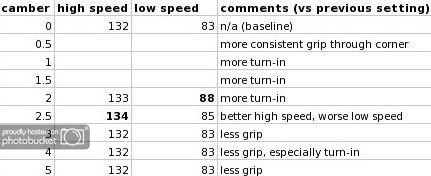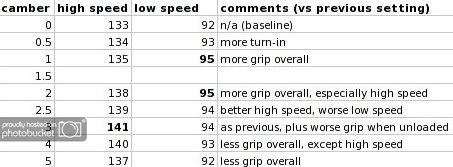nomis3613
Premium
- 831
Hi, Ive done some testing of camber, just thought Id share the results and get your thoughts. My aim is to have a better understanding of the actual effect of camber in GT5, rather than relying on real-life theory or results from GT3/GT4. I would like to be able support it with more numbers (ideally skidpad speeds) but unfortunately its not possible in GT5, so my results are a mix of cornering speeds and subjective impressions.
Test Method
Using an understeering car, measure front grip for various camber angles using mid-corner speed (for a low speed and a high speed corner) and comment on car feel. Repeat test for Sports Soft and Racing Soft tyres.
The car used was an Aston Martin DB7. Suspension settings were default, except for 0/0 toe and 1.2 deg rear camber. LSD settings were all minimum (not the best move in hindsight, more on that later...)
The track was Tokyo R246, chosen because it has long high speed and low speed turns, both without banking. High speed cornering was measured at turn 4. Low speed cornering was measured at turn 10.
Cornering speeds are the highest speeds where the car would hold the desired line (for example keeping within the lanes marked on the road). To try to obtain consistent results, the corners were taken as constant radius turns, instead of the normal method of hitting the apex. But it wasnt foolproof, so there is probably +/- 1km/h accuracy in the results. Speaking of which...
Results
high speed = km/h through high speed corner
low speed = km/h through low speed corner
comments = how the car felt compared with the previous camber angle (eg for 0.5 degrees it describes the difference compared to 0 degrees)
SPORTS SOFT

Notes: Lap times did not improve above 1.5 degrees, despite the improved turn-in. It felt like the car could not maintain the front grip after turn-in and the change in handling balance through the corner actually slowed it down (and it doesnt help that Im not a great driver!)
I tried to set the car up to understeer and remove any effects of the LSD, however as front grip improved it became obvious that power oversteer could be used to compensate for exit understeer. In hindsight, the LSD should have been tighter, however I tried to minimise the effect by avoiding throttle steer.
RACING SOFT

Although cornering speeds and lap times were still near their peak at 3 degrees, at this point the car started feeling awful to drive. I suspect this feeling was caused by big changes in grip due to weight transfer (unloaded grip started becoming a lot less than loaded grip) and the difference between high speed grip and low speed grip. The feeling got worse as camber was further increased.
My Theories
SPORT SOFT TYRES
1) increasing front camber improves turn-in, up to a point
2) there is an angle where low-speed grip is maximised
3) there is a higher angle where high-speed grip is maximised
4) above this, grip returns to the levels of 0 camber. I suspect tyre wear would increase with camber angle (not tested).
RACING SOFT TYRES
5) increasing front camber improves overall front grip, up to a point
6) camber has greater effect than for sports tyres, and higher angles are needed
7) there is an angle where low speed grip is maximised
8) there is an angle where high speed grip is maximised, but at this point low-speed grip and unloaded grip have decreased noticeably. Therefore choosing a camber angle is a more difficult decision than for sports tyres.
MISC
9) I have only tested one car, will be interested to see how it works for different weight distributions and drivetrains.
Discuss!
Test Method
Using an understeering car, measure front grip for various camber angles using mid-corner speed (for a low speed and a high speed corner) and comment on car feel. Repeat test for Sports Soft and Racing Soft tyres.
The car used was an Aston Martin DB7. Suspension settings were default, except for 0/0 toe and 1.2 deg rear camber. LSD settings were all minimum (not the best move in hindsight, more on that later...)
The track was Tokyo R246, chosen because it has long high speed and low speed turns, both without banking. High speed cornering was measured at turn 4. Low speed cornering was measured at turn 10.
Cornering speeds are the highest speeds where the car would hold the desired line (for example keeping within the lanes marked on the road). To try to obtain consistent results, the corners were taken as constant radius turns, instead of the normal method of hitting the apex. But it wasnt foolproof, so there is probably +/- 1km/h accuracy in the results. Speaking of which...
Results
high speed = km/h through high speed corner
low speed = km/h through low speed corner
comments = how the car felt compared with the previous camber angle (eg for 0.5 degrees it describes the difference compared to 0 degrees)
SPORTS SOFT

Notes: Lap times did not improve above 1.5 degrees, despite the improved turn-in. It felt like the car could not maintain the front grip after turn-in and the change in handling balance through the corner actually slowed it down (and it doesnt help that Im not a great driver!)
I tried to set the car up to understeer and remove any effects of the LSD, however as front grip improved it became obvious that power oversteer could be used to compensate for exit understeer. In hindsight, the LSD should have been tighter, however I tried to minimise the effect by avoiding throttle steer.
RACING SOFT

Although cornering speeds and lap times were still near their peak at 3 degrees, at this point the car started feeling awful to drive. I suspect this feeling was caused by big changes in grip due to weight transfer (unloaded grip started becoming a lot less than loaded grip) and the difference between high speed grip and low speed grip. The feeling got worse as camber was further increased.
My Theories
SPORT SOFT TYRES
1) increasing front camber improves turn-in, up to a point
2) there is an angle where low-speed grip is maximised
3) there is a higher angle where high-speed grip is maximised
4) above this, grip returns to the levels of 0 camber. I suspect tyre wear would increase with camber angle (not tested).
RACING SOFT TYRES
5) increasing front camber improves overall front grip, up to a point
6) camber has greater effect than for sports tyres, and higher angles are needed
7) there is an angle where low speed grip is maximised
8) there is an angle where high speed grip is maximised, but at this point low-speed grip and unloaded grip have decreased noticeably. Therefore choosing a camber angle is a more difficult decision than for sports tyres.
MISC
9) I have only tested one car, will be interested to see how it works for different weight distributions and drivetrains.
Discuss!

 ), but I will say that there are heaps and heaps of threads on here already explaining how camber works IRL. So I was hoping to have a discussion centered around observations of how it works in GT5. Post whatever you like about camber, but if you could keep this in mind, that would be ace!
), but I will say that there are heaps and heaps of threads on here already explaining how camber works IRL. So I was hoping to have a discussion centered around observations of how it works in GT5. Post whatever you like about camber, but if you could keep this in mind, that would be ace!
